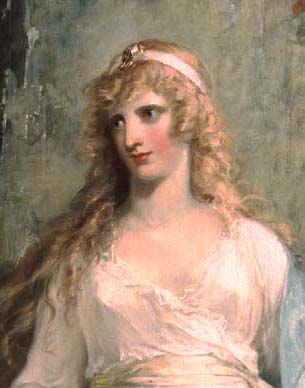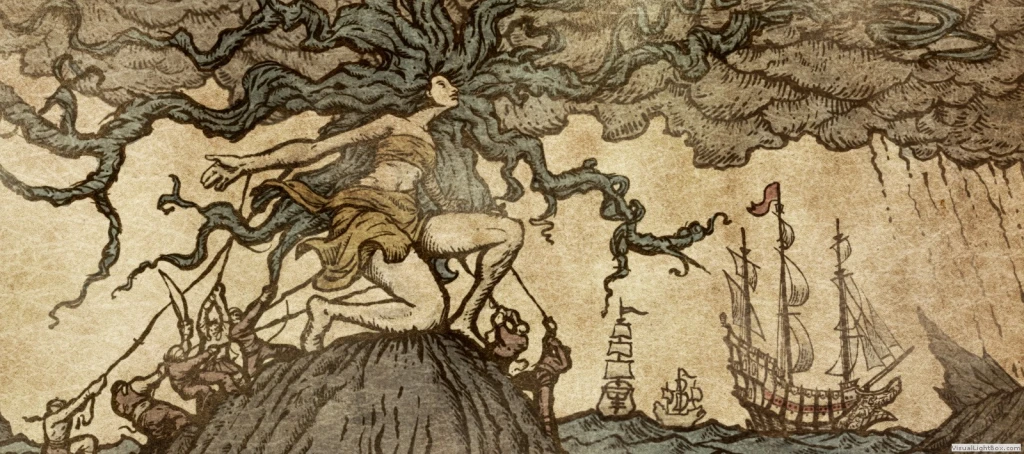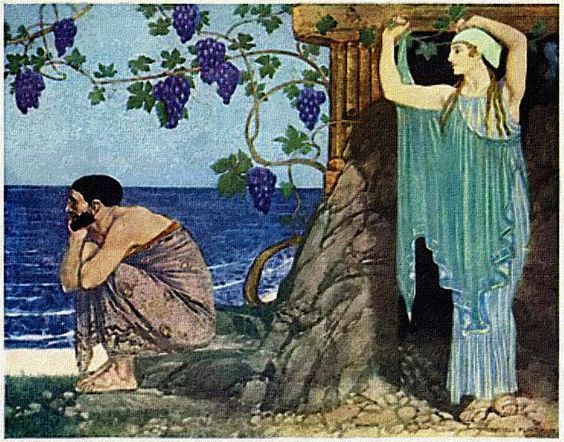(Artist Unknown, Found on Pinterest)
It may be my inner Disney fanatic coming out, but whenever I read the name Calypso, my mind immediately jumps to thinking about Pirates of the Caribbean. I remember my brother and I becoming absolutely obsessed with this franchise as children– to the point that we begged our parents to see “At World’s End” at least three times while it was in theatres in 2007.
While my brother was always a bigger fan of the epic action scenes and comedy elements of the series, I was always more drawn towards the deep lore and mythology of the series. I still remember feeling mesmerized by the depiction of an epic sea goddess such as Calypso—and I consider this childhood fascination an integral moment for my current appreciation of literature and art from all around the world.
Still, analyzing my specific history with the figure of Calypso, I remember feeling as though her origins in the franchise felt a little muddy, even as a child. I always assumed given the title of the film franchise, “Pirates of the Caribbean,” that Calypso’s origin came from some ancient mythological pantheon of Caribbean deities.
Flash forward to my freshman year of high school where I was asked to read a translation of Homer’s “The Odyssey,” and you can only imagine my surprise at the discovery that Calypso was a figure who actually originated from Greek mythology.
After recently revisiting “The Odyssey” once again and remembering my personal experiences with these differing depictions of Calypso, I began to fall down a rabbit hole of research about these two specific depictions of Calypso, with a few core questions to guide my writing:
“Why was the Greek figure of Calypso adapted to fit into the film franchise, ‘Pirates of the Caribbean?’
Do the differences in the depictions say something culturally about Ancient Greece vs. the Caribbean region?”
To begin to answer these questions, let’s begin by looking at the difference in physical appearance of these two iterations of Calypso—then we can begin to compare and contrast their stories:

A cropped section of Calypso receiving Telemachus by William Hamilton, depicting her as described in “The Odyssey.” 
Calypso as depicted in her human form, Tia Dalma, from “Pirates of the Caribbean.” Played by Naomie Harris.
In Book V of “The Odyssey,” we are introduced to Calypso as a beautiful singing goddess with braided curls and a long robe of silver, spending her time sitting and weaving on her paradisiacal island called Ogygia. Her beauty is described to be immaculate, far better than any mortal woman (including Odysseus’s wife, Penelope). This version of Calypso is enamored with the protagonist, Odysseus– having kept him on her island as a companion of love for seven years.
When Hermes comes to deliver Zeus’s message that Odysseus is to be set free from her island, Calypso believes the Gods to be hypocrites, never letting the Goddesses have their own mortal affairs. She even goes as far as to yell at Hermes, saying “You cruel, jealous gods! You bear a grudge whenever any goddess takes a man to sleep with as a lover in her bed” (183).
With this interaction, Calypso asserts her dominance and self-confidence in her own worth as an immortal Goddess. Despite this, she still recognizes that she ultimately can’t do anything about Zeus’s will, and she reluctantly aids Odysseus on his voyage from her island of paradise. Everything seems to be going smoothly for Odysseus—that is, until Poseidon intervenes in hopes of destroying Odysseus—until Athena intervenes to save him.

Speaking of the intervention of the other Gods, this is an element of the myth that doesn’t appear in the depiction of Calypso from “Pirates of the Caribbean.” Calypso seems to be the primary deity in the films, without any of the other “Heathen Gods” playing significant roles, like they do in “The Odyssey.” Instead of Gods, mortals seem to intervene with her fate.
In fact, when we first meet “Calypso” in the film franchise, we don’t even know she is a Goddess—she appears instead as a mystical witch called Tia Dalma who seems to practice a style of magic akin to voodoo. It turns out that the Goddess Calypso was somehow trapped and bonded to this human form by a council of pirates called the “First Brethren Court.”
In this depiction of Calypso, her human form Tia Dalma is shown living in an old wooden shack resting in a Cuban swamp bayou. This directly contrasts with Calypso’s island as described in the Odyssey, where Ogygia is shown as a paradise where “the scent of citrus and of brittle pine suffused the island,” with even Hermes “[gazing] around in wonder and joy, at sights to please even a god” (183).
This contrast in setting can also be representative of the contrasting demeanors of the Goddess depicted.
While Ogygia is portrayed as being beautiful, tropical, and lively, Cuba is portrayed as being desolate, worn-down, and gloomy. In a similar vein, Calypso in “The Odyssey” is initially seen as being confident, self-assured, and vibrantly feminine, while Calypso in “Pirates of the Caribbean” is seen as more closed-off, mysterious, and intimidating.

Odysseus and Calypso by Jan Brueghel the Elder in 1616, depicting the island of Ogygia, as described in “The Odyssey.” 
A photo of Tia Dalma’s residence on the Pantano River in Cuba from the POTC Wikia, as shown in “Pirates of the Caribbean.”
Looking more specifically at the lore of Tia Dalma/Calypso that captivated me as a child, it is now important to shift over towards the differing depictions of Calypso’s love affairs.
In “Pirates of the Caribbean,” Calypso is said to have fallen in love with a pirate named Davy Jones before the events of the films (and before she was trapped as Tia Dalma). Instead of trapping Jones on an island because of love, like her Greek counterpart, she instead entrusted him with the task of taking the souls of those who die at sea to the afterlife. Davy Jones was grateful for her love, and unlike Odysseus resisting his Calypso for seven years, Davy Jones made an agreement to return to land to embrace his lover Calypso every ten years.
After ten years, when Davy Jones returned to the island shore to be with Calypso, she wasn’t there. She describes how it is just her nature as an immortal Goddess to move on to other forms of love. I find this extreme contrast in the mythology to be very telling of the different depictions of the Goddess.
From what we see of Calypso in “The Odyssey,” she remains in her domain of Ogygia—finding joy when the mortal Odysseus happens to drift to the shore of her island. While Odysseus enjoys his affair with Calypso at first, he ultimately longs to return home to his wife.
Conversely, Calypso in her indescribable Goddess form before the events of “Pirates of the Caribbean” travels the world like the crashing tides of the ocean by her very nature. While Calypso enjoys her affair with Davy Jones at first, she ultimately gets bored of waiting for him to return to her, as they agreed—breaking his heart in the process.
With this twist of fate in the tragic love story of Davy Jones and Calypso, it is later revealed to Calypso (in one of my favorite scenes of the movies, with the clip provided below) that her former lover, Davy Jones, had conspired with the “First Brethren Court” to trap her in her human form.
To recap the differences, Calypso in “The Odyssey” ultimately played the role of the perpetrator who entrapped her love interest selfishly. Conversely, Calypso in “Pirates of the Caribbean” was entrapped by her former lover, Davy Jones, as the perpetrator.
Now, let’s revisit my leading questions:
“Why was the Greek figure of Calypso adapted to fit into the film franchise, ‘Pirates of the Caribbean?’
Do the differences in the depictions say something culturally about Ancient Greece vs. the Caribbean region?”
To answer this from a historical perspective, I think that when European colonizers came over to the Caribbean, they brought with them the knowledge of traditional Greek myths as passed down over generations from Homer. Upon seeing the more tropical islands of the Caribbean, they were likely reminded of the mythology of Calypso and her island in “The Odyssey.”
By bringing over these fantastic myths to a vastly different culture, I think the depiction of the Gods and Goddesses in general likely shifted depending on the state of the clashing cultures of the “New World” they settled in.
Calypso in “The Odyssey” was much more elegant and aware of her cultural circumstances– like the intervening of Gods such as Poseidon and Zeus. She knew her place culturally as a woman, despite being a Goddess, and was ultimately subservient because she was still worshipped, and her needs still catered on Ogygia by servants long after Odysseus left.
On the other hand, perhaps Calypso as portrayed in “Pirates of the Caribbean” says something about the culture of colonization from a Caribbean perspective. Calypso in “Pirates of the Caribbean” is much more vengeful towards her captors and only longs for her individual freedom, as if representative of the enslavement of indigenous people in the Caribbean during the age of piracy.
There are definitely some even deeper questions that these differing depictions of Calypso open up about the ways in which one figure can be adopted to fit within the mythology of another culture.
I am ultimately left with a better sense of how mythology is meant to serve as our means of understanding the vast world around us—with “new” versions of old myths constructed to answer our shifting cultural questions.

One thought on “Blog #4: Differing Depictions of Calypso: “From Ogygia to Cuba””